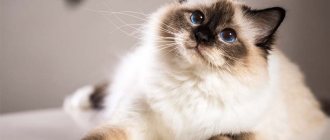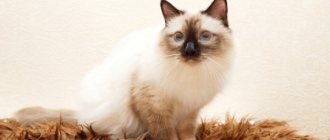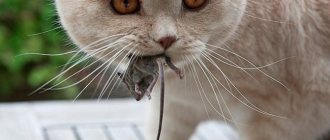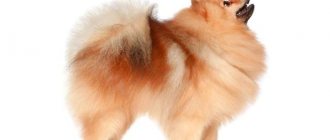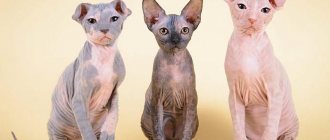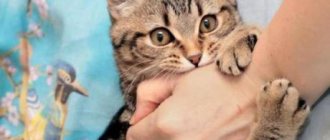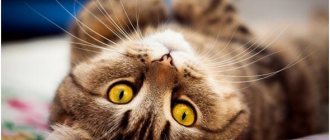A cat with a fluffy Persian “fur coat” of the color of a Siamese aristocrat, a soft, almost angelic character and an innate sense of dignity—is it just an amazing hybrid or a dream of a cat lover-aesthete? No more no less in front of you sacred burma. The famous fashion designer Karl Lagerfeld discovered his muse in one of the cats of the sacred Burmese breed. What is the animal that is being looked after by three specially trained maids? What secret does the sacred Burmese cat hide?
Brief history of the breed
The homeland of these cats is considered to be the peninsular state of Myanmar - as mysterious as the Bermuda Triangle, and until 1989 called Burma. Their history began in ancient times, and today it is almost impossible to say exactly where they came from.
It is known for certain that in ancient times similar cats lived at Buddhist temples. These animals supposedly protected them from robbers and dark forces.
There are many beautiful legends associated with the origin of Burma. It is possible that several breeds took part in its formation. Experts suggest that among her relatives are a short-haired Siamese and a fluffy Angora or Persian. For a long time, the Burmese cat was distributed only in Indochina.
In Europe they learned about it only in 1919, when the millionaire Vanderbilt brought it to France. For a lot of money, he bought two kittens, one of which died before reaching its destination. And the surviving female subsequently gave birth to babies, from which European breeding of the Burma began.
In 1925, the breed was officially registered in France. Today, the Burmese cat is recognized by all felinological associations in the world.
Interesting Facts
During the existence of the Burmese cat breed, a lot of interesting things happened to it:
- There is a beautiful legend associated with these animals. It is believed that Burma owes its unusual appearance and blue eyes to the goddess Tsun Huanze. During a battle with robbers who attacked the temple, a monk died. At that moment, his cat's yellow eyes turned sapphire, and his paws, immersed in the priest's gray hair, turned white. The frightened robbers, unable to resist the gaze of blue eyes, left the temple. After this incident, the breed received the name “sacred Burma”.
- These cats are real record holders. The female named Antigion became the most fertile - she gave birth to 19 kittens at once.
- Another sacred Burmese cat named Catalina was included in the pages of the Guinness Book of Records as the oldest - she lived for 35 years.
Photo
Everyone chooses a pet for themselves, assessing the beauty of the breed according to their own scale of beauty. World cinema star Romy Schneider, of all the purrs, preferred the Burmese cat. His name was Balzac de Ranchipur and this Burmese cat often posed in photos next to his famous owner.
And the singer Baptist Giabiconi gave the famous Karl Lagerzheld a Burmese cat. The cat's name is Choupette and she is famous all over the world. Not every pussy is looked after by three maids, recording every step in a special book, and Lagerfeld himself does not devote entire collections to each one. The designer himself believes that she is priceless and is not going to sell her, but fans are waiting for kittens from the famous pussy.
Breed description, standards, appearance
The Birman is a harmoniously built, stocky cat with well-developed muscles and a slightly elongated body. Her body is covered with silky semi-long hair of beautiful colors, in harmony with her sky-blue eyes. The exterior of the Burmese cat is described in more detail in the official standard.
Dimensions and weight
Burmese cats are a medium-sized breed, although their thick coat makes them look larger. An adult male weighs about 5-6 kg. The average weight of a female is 3-4 kg.
Anatomical characteristics
A typical Sacred Burmese breed should meet the following description:
- The head is proportional, almost round, with a wide muzzle, moderately long nose, strong chin, prominent cheeks and prominent cheekbones.
- The eyes are large and widely set. The color of the iris varies from light to dark blue.
- The ears are located on the sides of the head, slightly tilted forward. Hair grows profusely on the inside of the shell.
- The body is squat, elongated, with developed muscles, powerful bones and a muscular neck.
- The limbs are of medium length, thick with large round paws and strong claws. The interdigital space is overgrown with tufts of hair.
- The tail is of medium length, with rich feathering.
Color and coat type
The entire body of the sacred Burmese is covered with thick, luxurious semi-long hair, which forms fluffy “pants” on the hind legs and a chic “collar” on the neck.
The color of the representatives of the breed is similar to the color of the Siamese. There are clearly defined markings against a basic light background. The classic Burmese cat pattern is a chocolate brown pattern on a light beige coat.
The following colors are also acceptable in the breed:
- seal point;
- blue point;
- cream;
- lilac;
- red;
- cake;
- tabby
Important! The main characteristic that allows you to distinguish the sacred Burmese from cats of other breeds is the presence of pairs of symmetrical white “gloves”. On the front legs they do not rise above the pastern. On the hind legs they end in a sharp “spur” reaching to the middle of the lower leg.
Possible breed defects
Disadvantages in the presence of which the Burmese cat will not receive a high expert assessment:
- colored spots on the stomach and back;
- lack of “gloves”;
- eye color other than blue;
- knobby or curved tail;
- strabismus.
Character and temperament
The Sacred Birman is a calm, balanced and moderately active cat. She is very friendly, affectionate and playful. At the same time, she knows how to control herself and shows nobility in any situation.
The Burmese cat, whose character combines the desire for independence and dislike of loneliness, will not tolerate an indifferent attitude. She gets along with children without any problems and even in the midst of play will not scratch a child.
The Sacred Birman is able to coexist peacefully with non-aggressive dogs and cats of other breeds. But it is better to keep ornamental birds, rodents and aquarium fish away, since the hunting instinct in a cat can awaken at any moment.
Why is Burma considered sacred?
Myanmar is a state located in Southeast Asia, until 2010 it had a different name - Burma. In ancient times, a large number of temples were located on the territory of the state, in which people worshiped the goddess who was responsible for dead souls. This deity was believed to have bright blue eyes. Each temple was home to many cats with white fur, and the most important one, Sinh, was assigned to each high priest. One day there was an attack on the sacred place by robbers who killed the priest. Then Singh jumped on the dying old man and revived him, while all the cats in the temple changed color and eye color.
1111
How to choose the right kitten
To be sure of the purebred and health of your future pet, it is advisable to buy it from a trusted breeder or a certified nursery. At the time of sale, Burmese kittens must have documents confirming their origin and a passport with vaccination marks.
Kids should be well-groomed, active and moderately curious. The health of Burmese kittens can be judged by their soft bellies, clear eyes, fresh breath, and the absence of dirt under the tail and scratches on the skin.
On a note. Kittens of this breed are born completely white. Sacred Burmas acquire their final color by the age of one and a half years.
Kitten care
Burmese kittens from good nurseries go to new homes fully vaccinated and quite independent. They already eat many foods, go to the litter tray and know how to use a scratching post. New owners can only give the pet time to adapt and show where the bowls and cat litter are located.
Since small Burms are very curious and playful, wires, indoor plants, household chemicals, fragile and small things are hidden from them in advance. And so that the kittens do not suffer as a result of the owner’s carelessness, the doors of washing machines and ovens are closed from them.
To avoid digestive problems due to a sudden change in diet, at first the small Burmese is fed what the breeder advised. New foods are introduced into the kitten’s diet in stages to observe its body’s reaction.
The feeding regimen is set taking into account the age of the sacred Burma:
- up to 3 months – 5-6 times a day;
- 3-6 months – 4 times a day;
- 6-12 months – 3 times a day.
From the age of one year, the Burmese cat is switched to twice feeding.
Playfulness
Burmese kittens are very playful and incredibly funny. Often, this love of play remains with pets for life. It has been noticed that cats are more affectionate, sociable, and playful. Cats are less playful, they are more likely to show independence and wisdom.
As Burmese people age, games should become more intellectual. It’s not appropriate for an adult cat to chase a candy wrapper, but a cat puzzle, learning a series of commands or simple training will be a worthy pastime.
Care and maintenance
Despite the luxurious semi-long hair, Burmese cats come from a country with a warm climate. Therefore, they cannot tolerate precipitation and cold, which means they are not suitable for outdoor keeping. It is advisable to house representatives of the breed in warm rooms where the air temperature is maintained at 20-25 °C.
And in order for the sacred Burma to look neat, it is provided with complete care:
- The claws of a cat of this breed are shortened with a nail clipper as they grow. This should be done very carefully so as not to injure living tissues and cause pain to the pet.
- The animal's eyes and ears are regularly checked for any unusual discharge and wiped with a moistened cotton pad.
- The teeth of the sacred Burma are cleaned 2-3 times a month with a non-foaming paste, using a silicone brush or a special finger attachment.
- The coat of a cat of this breed does not require special care. In normal times, she is combed twice a week. During the molting period, the procedure is carried out more often to speed up the process. Bath your Burmese cat 3-4 times a year or as needed. To do this, use a special shampoo for fluffy breeds and warm water at a temperature of about 38 degrees.
On a note. Sacred Burma does not like water. To ensure that bathing procedures go quickly and calmly, cats are taught to bathe from an early age.
Difference from Ragdolls
Ragdolls differ from Birmans in their wedge-shaped head, widely spaced ears, and nose, which has a special proportion - the width is exactly half the length. For Ragdolls, spots on the paws are allowed, while for Burmese this feature is a factor for disqualification at the exhibition. In addition, representatives of this breed differ in character and temperament. Cats are calmer, less active, and also have the ability to relax the muscles of the entire body, hence the name “rag doll.”
Two Ragdoll cats
Feeding the cat
Unlike representatives of many other breeds, the Burmese cat is not prone to gluttony and gaining excess weight. No matter how much food is in her bowl, she will not eat more than she needs.
Since for the sacred Burma it is not the volume, but the quality of food that is important, the cat’s diet should be as complete and balanced as possible. The easiest way is to feed your animal premium or super premium dry food.
It is important that it contains enough protein and does not contain questionable ingredients such as soy, dyes and preservatives. The following brands of food are eaten best by sacred Burmas:
- Pronature;
- Hills;
- Bosch;
- Grandorf.
With a natural type of food, the cat’s diet is designed so that the share of meat is at least 70-80%. Also given to the sacred Burma:
- boiled vegetables;
- eggs;
- offal;
- porridge with water;
- lean sea fish;
- dairy products.
Sacred Burma should not be given bones, sweets, baked goods, fatty meats, river fish, sausages and pickles. It is also forbidden to feed the cat mushrooms, smoked meats and any leftovers from the owner’s table.
Nutrition
The favorite treat of Burmese pets is homemade meat. They prefer turkey, chicken and boiled fish. The main thing is that the food is not too fatty or salty, this can negatively affect the liver and kidneys. In addition, many people love special foods, which are very useful because they contain various vitamins and nutrients.
Small kittens should be given low-fat fermented milk products and minced meat (it is better digestible). This is necessary for healthy fur and the general condition of the pet.
For normal development, 150 g of food per meal is enough for them. They should be fed up to 4-5 times a day. Old cats also require the same feeding, but the dosage is increased to 200-250 g.
Education and physical activity
Burmese cats are endowed with high intelligence and excellent memory. They easily get used to the rules established in the owner's house and get accustomed to the tray and scratching post.
Burmese cats do not refuse to play and walk outside, but they can do without them. Unlike most other breeds, they do not land well. Therefore, sacred Burmese cats must be protected from jumping and accidental falls from heights.
Attitude towards other animals
Sacred Burma, as a rule, finds a common language with other pets sharing the same territory with her (although at first, manifestations of jealousy are not excluded). Smaller animals should still be isolated, since the hunting instinct of the Burmese is quite developed.
To eliminate manifestations of jealousy, the owner must develop the correct tactics of behavior: the animals should be given equal attention, without depriving anyone. Conflicts are excluded if animals grow up together, getting used to the house, owners, and surroundings.
The issue of dominance may arise if animals appeared in the house as adults (especially if they are unsterilized). Castrated and sterilized Burmese, as a rule, do not display jealousy or aggression.
Vaccinations and antiparasitic treatment
To prevent viral and infectious diseases, the sacred Burmese cat is regularly vaccinated against rhinotracheitis, calcivirosis and panleukopenia. The first vaccination is given to the animal at the age of 7-8 weeks.
After 4 weeks, the Burmese kitten is re-vaccinated against the same diseases and against rabies. Subsequently, the cat is vaccinated once a year.
To protect the sacred Burma from diseases carried by parasites, it is periodically treated against fleas and worms. Anthelmintic drugs are given to the cat twice a year with mandatory repetition after 10-14 days.
To combat fleas, drops and shampoos are used. And if a Burmese cat goes outside even occasionally, it is additionally protected with an anti-parasitic collar.
Health
No genetic diseases have been identified in Burma. Despite this, it should be recalled that timely vaccinations and visits to a specialist are the key to the health and happy life of an animal. These are physically healthy cats that prefer to live indoors. They don’t really need walks, because they are afraid of drafts, precipitation, and low temperatures. In good weather, pets can soak up the sunny meadow. If it is not possible to walk the cat, it is enough to simply ventilate the apartment. It is not recommended to leave an animal unattended in a room with an open window. Jumping even from the first floor, a cat can break its limbs; Burms do not know how to land deftly. Street living conditions shock animals; they are not adapted to the struggle for survival, so they most often die. Like all pets, they need vaccinations and periodic visits to the veterinarian.
Pros and cons of the breed
Reviews from owners of sacred Burmese cats are mainly about their external attractiveness and calm, non-conflict disposition. But among the owners of animals of this breed there are also those who are dissatisfied with the need to care for their pets’ thick, luxurious fur coat.
| pros | Minuses |
| Beautiful exterior | Unadapted to cold climates |
| Peaceful disposition | High cost of kittens |
| High intelligence |
The Sacred Birman is a cute shaggy cat with a good-natured and calm character. She will be an excellent companion for people who lead a measured lifestyle and are ready to give her warmth and care.
